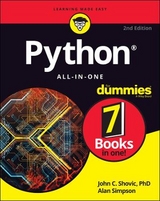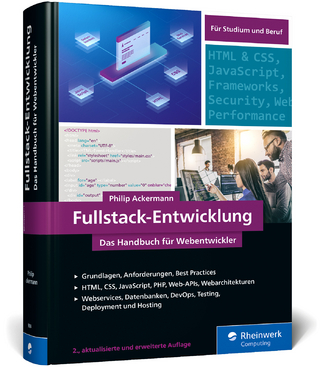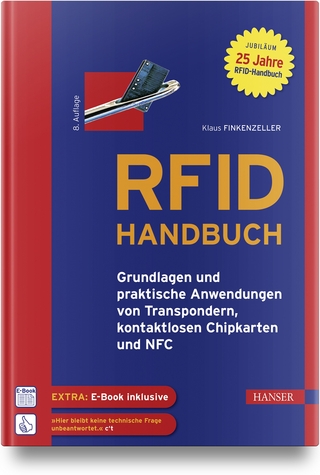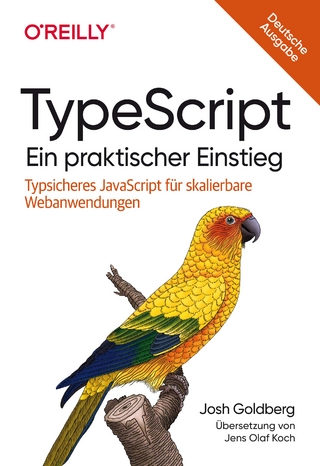
Python All–in–One For Dummies
John Wiley & Sons Inc (Verlag)
978-1-119-55759-3 (ISBN)
- Titel ist leider vergriffen;
keine Neuauflage - Artikel merken
Thanks to its flexibility, Python has grown to become one of the most popular programming languages in the world. Developers use Python in app development, web development, data science, machine learning, and even in coding education classes.
There's almost no type of project that Python can't make better. From creating apps to building complex websites to sorting big data, Python provides a way to get the work done. Python All-in-One For Dummies offers a starting point for those new to coding by explaining the basics of Python and demonstrating how it’s used in a variety of applications.
Covers the basics of the language
Explains its syntax through application in high-profile industries
Shows how Python can be applied to projects in enterprise
Delves into major undertakings including artificial intelligence, physical computing, machine learning, robotics and data analysis
This book is perfect for anyone new to coding as well as experienced coders interested in adding Python to their toolbox.
John Shovic is a computer science faculty member at the University of Idaho. Alan Simpson is a web development professional and prolific tech author with over 100 publications to his credit.
Introduction 1
About This Book 1
Foolish Assumptions 2
Icons Used in This Book 2
Beyond the Book 3
Where to Go from Here 3
Book 1: Getting Started with Python 5
Chapter 1: Starting with Python 7
Why Python is Hot 8
Choosing the Right Python 9
Tools for Success 11
An excellent, free learning environment 12
Installing Anaconda and VS Code 13
Writing Python in VS Code 17
Choosing your Python interpreter 19
Writing some Python code 20
Getting back to VS Code Python 21
Using Jupyter Notebook for Coding 21
Chapter 2: Interactive Mode, Getting Help, Writing Apps 27
Using Python Interactive Mode 27
Opening Terminal 28
Getting your Python version 28
Going into the Python Interpreter 30
Entering commands 30
Using Python’s built-in help 31
Exiting interactive help 33
Searching for specific help topics online 33
Lots of free cheat sheets 34
Creating a Python Development Workspace 34
Creating a Folder for your Python Code 37
Typing, Editing, and Debugging Python Code 39
Writing Python code 40
Saving your code 41
Running Python in VS Code 41
Simple debugging 42
The VS Code Python debugger 43
Writing Code in a Jupyter Notebook 45
Creating a folder for Jupyter Notebook 45
Creating and saving a Jupyter notebook 46
Typing and running code in a notebook 46
Adding some Markdown text 47
Saving and opening notebooks 48
Chapter 3: Python Elements and Syntax 49
The Zen of Python 49
Object-Oriented Programming 53
Indentations Count, Big Time 54
Using Python Modules 56
Syntax for importing modules 58
Using an alias with modules 59
Chapter 4: Building Your First Python Application 61
Open the Python App File 62
Typing and Using Python Comments 63
Understanding Python Data Types 64
Numbers 65
Words (strings) 66
True/false Booleans 68
Doing Work with Python Operators 69
Arithmetic operators 69
Comparison operators 70
Boolean operators 71
Creating and Using Variables 72
Creating valid variable names 73
Creating variables in code 74
Manipulating variables 75
Saving your work 76
Running your Python app in VS Code 76
What Syntax is and Why It Matters 78
Putting Code Together 82
Book 2: Understanding Python Building Blocks 83
Chapter 1: Working with Numbers, Text, and Dates 85
Calculating Numbers with Functions 86
Still More Math Functions 88
Formatting Numbers 91
Formatting with f-strings 91
Showing dollar amounts 92
Formatting percent numbers 93
Making multiline format strings 95
Formatting width and alignment 96
Grappling with Weirder Numbers 98
Binary, octal, and hexadecimal numbers 98
Complex numbers 99
Manipulating Strings 100
Concatenating strings 101
Getting the length of a string 102
Working with common string operators 102
Manipulating strings with methods 105
Uncovering Dates and Times 107
Working with dates 108
Working with times 112
Calculating timespans 114
Accounting for Time Zones 118
Working with Time Zones 120
Chapter 2: Controlling the Action 125
Main Operators for Controlling the Action 125
Making Decisions with if 126
Adding else to your if login 130
Handling multiple else’s with elif 131
Ternary operations 133
Repeating a Process with for 134
Looping through numbers in a range 134
Looping through a string 136
Looping through a list 137
Bailing out of a loop 138
Looping with continue 140
Nesting loops 140
Looping with while 141
Starting while loops over with continue 143
Breaking while loops with break 144
Chapter 3: Speeding Along with Lists and Tuples 147
Defining and Using Lists 147
Referencing list items by position 148
Looping through a list 150
Seeing whether a list contains an item 150
Getting the length of a list 151
Adding an item to the end of a list 151
Inserting an item into a list 152
Changing an item in a list 153
Combining lists 153
Removing list items 154
Clearing out a list 156
Counting how many times an item appears in a list 157
Finding an list item’s index 158
Alphabetizing and sorting lists 159
Reversing a list 161
Copying a list 162
What’s a Tuple and Who Cares? 163
Working with Sets 165
Chapter 4: Cruising Massive Data with Dictionaries 169
Creating a Data Dictionary 171
Accessing dictionary data 172
Getting the length of a dictionary 174
Seeing whether a key exists in a dictionary 175
Getting dictionary data with get() 176
Changing the value of a key 177
Adding or changing dictionary data 177
Looping through a Dictionary 179
Data Dictionary Methods 181
Copying a Dictionary 182
Deleting Dictionary Items 182
Using pop() with Data Dictionaries 184
Fun with Multi-Key Dictionaries 186
Using the mysterious fromkeys and setdefault methods 188
Nesting Dictionaries 190
Chapter 5: Wrangling Bigger Chunks of Code 193
Creating a Function 194
Commenting a Function 195
Passing Information to a Function 196
Defining optional parameters with defaults 198
Passing multiple values to a function 199
Using keyword arguments (kwargs) 200
Passing multiple values in a list 202
Passing in an arbitrary number of arguments 204
Returning Values from Functions 205
Unmasking Anonymous Functions 206
Chapter 6: Doing Python with Class 213
Mastering Classes and Objects 213
Creating a Class 216
How a Class Creates an Instance 217
Giving an Object Its Attributes 218
Creating an instance from a class 219
Changing the value of an attribute 222
Defining attributes with default values 222
Giving a Class Methods 224
Passing parameters to methods 226
Calling a class method by class name 227
Using class variables 228
Using class methods 230
Using static methods 232
Understanding Class Inheritance 234
Creating the base (main) class 236
Defining a subclass 237
Overriding a default value from a subclass 239
Adding extra parameters from a subclass 239
Calling a base class method 242
Using the same name twice 243
Chapter 7: Sidestepping Errors 247
Understanding Exceptions 247
Handling Errors Gracefully 251
Being Specific about Exceptions 252
Keeping Your App from Crashing 253
Adding an else to the Mix 255
Using try … … … except else finally 257
Raising Your Own Errors 259
Book 3: Working with Python Libraries 265
Chapter 1: Working with External Files 267
Understanding Text and Binary Files 267
Opening and Closing Files 269
Reading a File’s Contents 276
Looping through a File 277
Looping with readlines() 277
Looping with readline() 279
Appending versus overwriting files 280
Using tell() to determine the pointer location 281
Moving the pointer with seek() 283
Reading and Copying a Binary File 283
Conquering CSV Files 286
Opening a CSV file 288
Converting strings 290
Converting to integers 291
Converting to date 292
Converting to Boolean 293
Converting to floats 293
From CSV to Objects and Dictionaries 295
Importing CSV to Python objects 296
Importing CSV to Python dictionaries 299
Chapter 2: Juggling JSON Data 303
Organizing JSON Data 303
Understanding Serialization 306
Loading Data from JSON Files 307
Converting an Excel date to a JSON date 309
Looping through a keyed JSON file 310
Converting firebase timestamps to Python dates 313
Loading unkeyed JSON from a Python string 314
Loading keyed JSON from a Python string 315
Changing JSON data 316
Removing data from a dictionary 317
Dumping Python Data to JSON 318
Chapter 3: Interacting with the Internet 323
How the Web Works 323
Understanding the mysterious URL 324
Exposing the HTTP headers 325
Opening a URL from Python 327
Posting to the Web with Python 328
Scraping the Web with Python 330
Parsing part of a page 333
Storing the parsed content 333
Saving scraped data to a JSON file 335
Saving scraped data to a CSV file 336
Chapter 4: Libraries, Packages, and Modules 339
Understanding the Python Standard Library 339
Using the dir() function 340
Using the help() function 341
Exploring built-in functions 343
Exploring Python Packages 343
Importing Python Modules 345
Making Your Own Modules 348
Book 4: Using Artificial Intelligence in Python 353
Chapter 1: Exploring Artificial Intelligence 355
AI is a Collection of Techniques 356
Neural networks 356
Machine learning 359
TensorFlow — A framework for deep learning 361
Current Limitations of AI 363
Chapter 2: Building a Neural Network in Python 365
Understanding Neural Networks 366
Layers of neurons 367
Weights and biases 368
The activation function 369
Loss function 369
Building a Simple Neural Network in Python 370
The neural-net Python code 370
Using TensorFlow for the same neural network 381
Installing the TensorFlow Python library 382
Building a Python Neural Network in TensorFlow 383
Loading your data 384
Defining your neural-network model and layers 384
Compiling your model 384
Fitting and training your model 384
Breaking down the code 386
Evaluating the model 388
Changing to a three-layer neural network in TensorFlow/Keras 390
Chapter 3: Doing Machine Learning in Python 393
Learning by Looking for Solutions in All the Wrong Places 394
Classifying Clothes with Machine Learning 395
Training and Learning with TensorFlow 395
Setting Up the Software Environment for this Chapter 396
Creating a Machine-Learning Network for Detecting Clothes Types 397
Getting the data — The Fashion-MNIST dataset 398
Training the network 398
Testing our network 398
Breaking down the code 399
Results of the training and evaluation 402
Testing a single test image 402
Testing on external pictures 403
The results, round 1 405
The CNN model code 406
The results, round 2 409
Visualizing with MatPlotLib 409
Learning More Machine Learning 413
Chapter 4: Exploring More AI in Python 415
Limitations of the Raspberry Pi and AI 415
Adding Hardware AI to the Raspberry Pi 418
AI in the Cloud 420
Google cloud 421
Amazon Web Services 421
IBM cloud 422
Microsoft Azure 422
AI on a Graphics Card 423
Where to Go for More AI Fun in Python 424
Book 5: Doing Data Science with Python 427
Chapter 1: The Five Areas of Data Science 429
Working with Big, Big Data 430
Volume 430
Variety 431
Velocity 431
Managing volume, variety, and velocity 432
Cooking with Gas: The Five Step Process of Data Science 432
Capturing the data 433
Processing the data 433
Analyzing the data 434
Communicating the results 434
Maintaining the data 435
Chapter 2: Exploring Big Data with Python 437
Introducing NumPy, Pandas, and MatPlotLib 438
Doing Your First Data Science Project 440
Diamonds are a data scientist’s best friend 440
Breaking down the code 443
Visualizing the data with MatPlotLib 444
Chapter 3: Using Big Data from the Google Cloud 451
What is Big Data? 451
Understanding the Google Cloud and BigQuery 452
The Google Cloud Platform 452
BigQuery from Google 452
Computer security on the cloud 453
Signing up on Google for BigQuery 454
Reading the Medicare Big Data 454
Setting up your project and authentication 454
The first big-data code 457
Breaking down the code 460
A bit of analysis next 461
Payment percent by state 464
And now some visualization 465
Looking for the Most Polluted City in the World on an Hourly Basis 466
Book 6: Talking to Hardware with Python 469
Chapter 1: Introduction to Physical Computing 471
Physical Computing is Fun 472
What is a Raspberry Pi? 472
Making Your Computer Do Things 474
Using Small Computers to Build Projects That Do and Sense Things 474
The Raspberry Pi: A Perfect Platform for Physical Computing in Python 476
GPIO pins 477
GPIO libraries 477
The hardware for “Hello World” 478
Assembling the hardware 478
Controlling the LED with Python on the Raspberry Pi 482
But Wait, There is More 485
Chapter 2: No Soldering! Grove Connectors for Building Things 487
So What is a Grove Connector? 488
Selecting Grove Base Units 489
For the Arduino 489
Raspberry Pi Base Unit — the Pi2Grover 490
The Four Types of Grove Connectors 492
The Four Types of Grove Signals 493
Grove digital — All about those 1’s and 0’s 493
Grove analog: When 1’s and 0’s aren’t enough 494
Grove UART (or serial) — Bit by bit transmission 495
Grove I2C — Using I2C to make sense of the world 497
Using Grove Cables to Get Connected 499
Grove Patch Cables 499
Chapter 3: Sensing the World with Python: The World of I2C 505
Understanding I2C 506
Exploring I2C on the Raspberry Pi 507
Talking to I2C devices with Python 508
Reading temperature and humidity from an I2C
device using Python 511
Breaking down the program 514
A Fun Experiment for Measuring Oxygen and a Flame 517
Analog-to-digital converters (ADC) 518
The Grove oxygen sensor 519
Hooking up the oxygen experiment 520
Breaking down the code 522
Building a Dashboard on Your Phone Using Blynk and Python 525
HDC1080 temperature and humidity sensor redux 525
How to add the Blynk dashboard 527
The modified temperatureTest.py software for the Blynk app 531
Breaking down the code 533
Where to Go from Here 536
Chapter 4: Making Things Move with Python 537
Exploring Electric Motors 538
Small DC motors 538
Servo motors 539
Stepper motors 539
Controlling Motors with a Computer 540
Python and DC Motors 540
Python and running a servo motor 548
Python and making a stepper motor step 554
Book 7: Building Robots with Python 565
Chapter 1: Introduction to Robotics 567
A Robot is Not Always like a Human 567
Not Every Robot Has Arms or Wheels 568
The Wilkinson Bread-Making Robot 569
Baxter the Coffee-Making Robot 570
The Griffin Bluetooth-enabled toaster 571
Understanding the Main Parts of a Robot 572
Computers 572
Motors and actuators 573
Communications 573
Sensors 573
Programming Robots 574
Chapter 2: Building Your First Python Robot 575
Introducing the Mars Rover PiCar-B 575
What you need for the build 576
Understanding the robot components 577
Assembling the Robot 586
Calibrating your servos 588
Running tests on your rover in Python 591
Installing software for the CarPi-B Python test 591
The PiCar-B Python test code 592
Pi camera video testing 592
Chapter 3: Programming Your Robot Rover in Python 595
Building a Simple High-Level Python Interface 595
The motorForward function 596
The wheelsLeft function 596
The wheelsPercent function 596
Making a Single Move with Python 597
Functions of the RobotInterface Class 598
Front LED functions 598
Pixel strip functions 600
Ultrasonic distance sensor function 601
Main motor functions 602
Servo functions 603
General servo function 606
The Python Robot Interface Test 606
Coordinating Motor Movements with Sensors 610
Making a Python Brain for Our Robot 613
A Better Robot Brain Architecture 620
Overview of the Included Adeept Software 621
Where to Go from Here? 622
Chapter 4: Using Artificial Intelligence in Robotics 623
This Chapter’s Project: Going to the Dogs 624
Setting Up the Project 624
Machine Learning Using TensorFlow 625
The code 627
Examining the code 629
The results 632
Testing the Trained Network 633
The code 634
Explaining the code 636
The results 637
Taking Cats and Dogs to Our Robot 640
The code 640
How it works 643
The results 643
Other Things You Can Do with AI Techniques and the Robot 645
Cat/Not Cat 645
Santa/Not Santa 646
Follow the ball 646
Using Alexa to control your robot 646
AI and the Future of Robotics 646
Index 647
| Erscheinungsdatum | 03.05.2019 |
|---|---|
| Verlagsort | New York |
| Sprache | englisch |
| Maße | 173 x 235 mm |
| Gewicht | 970 g |
| Themenwelt | Mathematik / Informatik ► Informatik ► Programmiersprachen / -werkzeuge |
| ISBN-10 | 1-119-55759-3 / 1119557593 |
| ISBN-13 | 978-1-119-55759-3 / 9781119557593 |
| Zustand | Neuware |
| Informationen gemäß Produktsicherheitsverordnung (GPSR) | |
| Haben Sie eine Frage zum Produkt? |
aus dem Bereich



